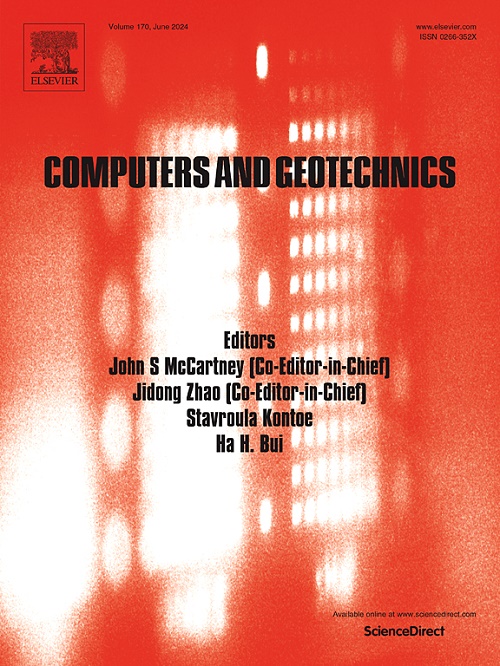考虑混合和分离的土流耦合问题的统一数值框架
IF 6.2
1区 工程技术
Q1 COMPUTER SCIENCE, INTERDISCIPLINARY APPLICATIONS
引用次数: 0
摘要
准确模拟大变形下的土-流体耦合对于理解和预测边坡破坏、路堤坍塌和其他岩土灾害等现象至关重要。这一主题已经研究了几十年,由于岩土结构的非线性响应,这通常是由土壤骨架的塑性屈服和有限变形引起的,因此仍然具有挑战性。在这项工作中,我们全面总结了土-流体耦合问题所涉及的理论。在有限应变框架内,我们采用线性硬化的弹塑性本构模型来表示固体骨架,并采用几乎不可压缩的水模型。含水量通过影响固体骨架的内聚力来影响骨架的行为。采用质点法对控制方程进行离散化,采用两组质点分别独立表示实体骨架和流体。通过水对干土和湿土影响的模拟结果与实验结果对比,验证了所提方法的有效性。通过两种情况进一步证明了该方法的能力:(1)刚体对饱和土的冲击导致渗水,(2)考虑地基侵蚀的沟渠填筑。这项工作可以为分析流体和固体相互作用的动态响应提供一个通用的工具,同时考虑混合和分离现象。本文章由计算机程序翻译,如有差异,请以英文原文为准。
A unified numerical framework for the soil and fluid coupling problem considering mixture and separation
Accurately modeling soil–fluid coupling under large deformations is critical for understanding and predicting phenomena such as slope failures, embankment collapses, and other geotechnical hazards. This topic has been studied for decades and remains challenging due to the nonlinear responses of geotechnical structures, which typically result from plastic yielding and finite deformation of the soil skeleton. In this work, we comprehensively summarize the theory involved in the soil–fluid coupling problem. Within a finite strain framework, we employ an elasto-plastic constitutive model with linear hardening to represent the solid skeleton and a nearly incompressible model for water. The water content influences the behavior of the solid skeleton by affecting its cohesion. The governing equations are discretized by material point method and two sets of material points are employed to independently represent solid skeleton and fluid, respectively. The proposed method is validated by comparing simulation results with experimental results for the impact of water on dry soil and wet soil. The capability of the method is further demonstrated through two cases: (1) the impact of a rigid body on saturated soil, causing water seepage, and (2) the filling of a ditch, which considers the erosion of the foundation. This work may provide a versatile tool for analyzing the dynamic responses of fluid and solid interactions, considering both mixing and separation phenomena.
求助全文
通过发布文献求助,成功后即可免费获取论文全文。
去求助
来源期刊

Computers and Geotechnics
地学-地球科学综合
CiteScore
9.10
自引率
15.10%
发文量
438
审稿时长
45 days
期刊介绍:
The use of computers is firmly established in geotechnical engineering and continues to grow rapidly in both engineering practice and academe. The development of advanced numerical techniques and constitutive modeling, in conjunction with rapid developments in computer hardware, enables problems to be tackled that were unthinkable even a few years ago. Computers and Geotechnics provides an up-to-date reference for engineers and researchers engaged in computer aided analysis and research in geotechnical engineering. The journal is intended for an expeditious dissemination of advanced computer applications across a broad range of geotechnical topics. Contributions on advances in numerical algorithms, computer implementation of new constitutive models and probabilistic methods are especially encouraged.
 求助内容:
求助内容: 应助结果提醒方式:
应助结果提醒方式:


